Swirling seas of plastic trash
Long-lasting oceanic garbage threatens marine life
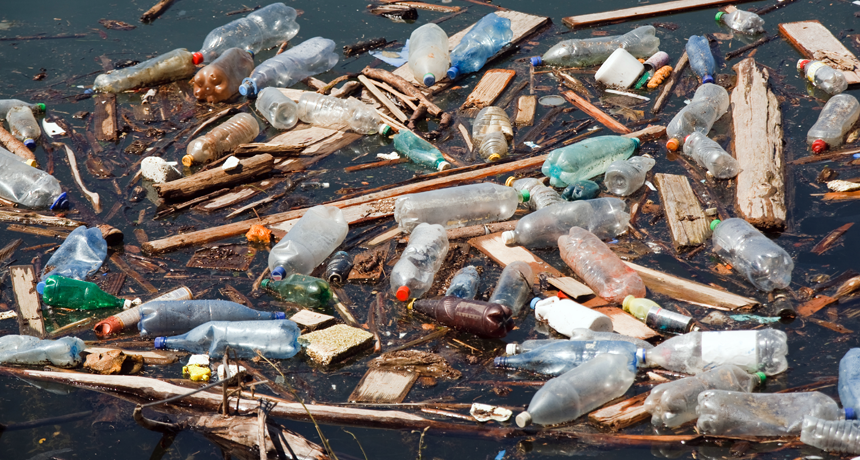
Plastic washes off of beaches and into the ocean. It can ten collect in some currents and get deposited on coastal beaches. The sea literally dumps tons of plastic waste each year, for instance, on Hawaii’s Kamilo Beach.
Smithore / iStockphoto
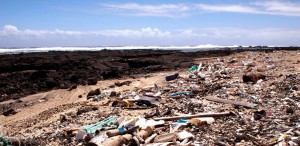
Kamilo, on the Big Island of Hawaii, is no ordinary beach. While it has sand, most of the island is made up of cooled chunks of lava rock that formed when Mauna Loa, one of the island’s volcanoes, erupted in 1868.
There are no roads that lead to Kamilo (pronounced: ka-MEE-low). The only way to get there is to drive for two hours over piles of volcanic rock. I share a ride with some locals and a scientist, and we bounce wildly and try to keep our heads from bumping the ceiling of the truck. When we arrive, the beach is deserted. There are no sunbathers, no swimmers and no surfers, and the gusts of wind blowing off the ocean are so strong that it’s hard to keep our balance.
But the strangest thing about Kamilo is that it’s covered with plastic trash — things that we use every day. I find shoes, combs, laundry baskets, Styrofoam, toothbrushes and countless water bottles. There are even toys like LEGO blocks and a little green army man. Beneath the recognizable things are millions of tiny, colorful plastic pieces — the fragments of broken-down larger objects. They look like confetti.
None of this trash was left by careless beachgoers. It looks like it has spent a long time in the ocean, being tossed about by waves. The objects are faded and brittle, and some have big chunks missing, as if they have been chewed on.
Plastic trash in the ocean and on beaches harms sea animals of every size, from microscopic organisms called phytoplankton to whales. Some eat the trash, thinking it’s food. The animals’ stomachs fill up with garbage, and if they can’t poop it out, they die. Other animals get tangled in the trash and drown. This trash may even contain dangerous chemicals that are making their way into the seafood we eat.
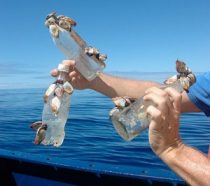
Noni Sanford lives on the Big Island and regularly cleans Kamilo with a group of volunteers. She says that before the cleanups started, the trash was piled 8 to 10 feet high. It’s much better now, but each year, the volunteers still remove between 15 and 20 tons of new trash from Kamilo and other beaches that stretch nine miles up the coast. That’s enough junk to fill 1.5 to two garbage trucks to the brim. “It’s overwhelming,” Sanford says.
How could a beach that no one visits have so much garbage? Scientists now know the answer — the trash is coming from the middle of the ocean.
Plastic in the middle of nowhere
Miriam Goldstein is a biological oceanographer at the Scripps Institution of Oceanography in San Diego. In 2009, Goldstein and a team of scientists sailed to an area of the North Pacific Ocean about 1,000 miles west of California and 1,000 miles northeast of Hawaii. “It was really as far in the middle of nowhere as you can get,” Goldstein says. She had heard about people finding plastic trash in this spot and wanted to see if she could find plastic there as well.
Goldstein was surprised by how much junk there was in the area. “We saw a lot of large objects floating by, construction hats, fishing nets, bottles,” Goldstein says. “But mostly there were just lots of little pieces that you could barely see [when] looking over the side of the boat.”
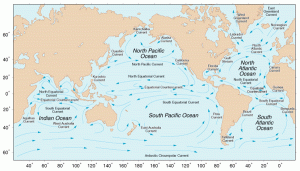
Goldstein and her crew used a special net designed to catch plankton to skim the ocean’s surface. The net’s mouth is 3 feet wide and its mesh is very fine, smaller than the holes you can see in your T-shirt when you stretch it. In 15 minutes, the net filters a patch of ocean roughly the size of a football field’s end zone.
The scientists collected 132 samples from a 1,700-mile stretch of ocean. That’s almost as long as the distance between New York City and Denver. All but two samples contained plastic. Plastic is produced on land. Yet, here scientists were finding it more than 1,000 miles from the nearest land!
Goldstein is doing experiments to see if the plastic affects sea animals on the ocean’s surface. Some of the plastic pieces she found were home to organisms like barnacles, which need a hard surface to grow on. At sea, barnacles are usually found living on floating pieces of wood. But if plastic trash offers more surface area, the barnacle population could grow larger than it would without the abundant plastics. This would give barnacles an unfair advantage over other species, which in turn could alter the balance of animals in the ocean ecosystem.
Bubbles in a bathtub
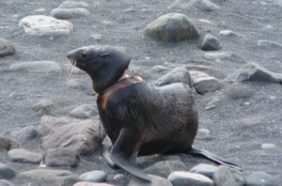
Goldstein and her crew found so much plastic because they were in a special area of the North Pacific called a gyre. A gyre is a vast expanse of water surrounded by a loop of fast-moving ocean currents. Strong winds blow trash from the beaches of countries that border the North Pacific — such as the United States, Canada, Mexico, Japan and China — into the gyre’s currents. Some trash stays within these currents, but wind also sweeps a lot of the garbage into the center of the gyre.
Within this eye of the gyre, small surface currents churn slowly due to Earth’s rotation. There is very little wind in the center of the gyre, so the water there is usually calm. Plastic trash carried into the gyre gets trapped, and because most plastic floats, it accumulates at the surface like bubbles in a bathtub. Passing storm winds can lift trash out of the gyre. Because Hawaii is located near the gyre’s southern edge, storm winds blow trash onto Hawaiian beaches — including Kamilo.
But the gyre in the North Pacific isn’t the only one in the world’s oceans. There are four other major gyres, located in the South Pacific, South Atlantic, North Atlantic and Indian oceans. Scientists have found large amounts of plastic in the North Atlantic, but they don’t know if plastic is also collecting in the other three gyres, because they have yet to be studied. However, a group of conservationists and concerned citizens recently visited these remaining gyres and reported finding plastic in each one.
2.4 million pounds
A team of scientists at the Sea Education Association, or SEA, in Woods Hole, Mass., has been collecting plastic in the North Atlantic gyre for the past 22 years. Using a net similar to Goldstein’s, the scientists have gathered more than 6,100 samples. Sixty-two percent of those samples contained plastic pieces that were 10 millimeters or smaller in size and had an average mass of less than 0.15 grams. This means that the pieces were no bigger than a pencil eraser and one-tenth as heavy as a paper clip.
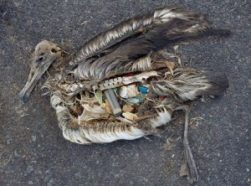
The scientists painstakingly counted each tiny, plastic fragment by hand, using a tool resembling tweezers. The team estimated that the region contains 2.4 million pounds of plastic. If all of those plastic pieces were laid across an area the size of a football field, they’d form a layer almost 6 inches deep.
Because those pieces are instead scattered throughout the North Atlantic gyre, there are only a few in any one place. That may not sound like much, but the problem with plastic is that it can’t quickly biodegrade, or be broken down by living organisms. Crashing waves and constant sunlight cause the plastic to crumble into smaller and smaller pieces. Some scientists think the pieces can take hundreds of years to completely disappear.
Because the plastic hangs around for so long, many animals interact with it. In fact, SEA chemical oceanographer Giora Proskurowski says the smallest pieces may be the most devastating to the ocean ecosystem, “because now you’re dealing with things that zooplankton might eat.” Zooplankton are small ocean animals at the base of the food chain. So perhaps the biggest question scientists are asking now is: How might plastic trash affect the health of sea life?
Saving tangled seals
Scientists have long known that large pieces of plastic junk harm or kill countless sea animals each year. Michael Williams, a researcher with the National Oceanic and Atmospheric Administration, studies northern fur seals on the Pribilof Islands off the coast of Alaska. Between 1998 and 2006, Williams and his team saw more than 800 young male seals swim ashore tangled up in trash.
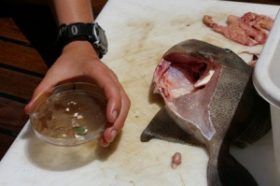
Every winter, the seals migrate through the northern edge of the North Pacific gyre, where garbage like plastic bands and fishing line can get wrapped around the seals’ necks and flippers. The more a seal tries to wiggle free, the tighter the trash’s grip can become, sometimes digging into the animal’s flesh and killing it.
Williams and his team capture and cut the trash off of as many entangled seals as possible. It’s hard work because the seals move fast, are very strong and bite. It takes three to five people to restrain each seal, which typically weighs between 23 and 45 kilograms (or 50 and 100 pounds). “Sometimes whatever they’re tangled in is just horribly embedded, so we end up having to really dig in and fight to cut it off,” says Williams.
This often forces researchers to ask a tough question: Will they hurt the animal more by trying to free it? Sometimes, the researchers just have to let the seal go, knowing it will probably die. “It can be devastating,” says Williams.
Bellies full of bottle caps
Other sea animals eat the plastic, thinking it’s food. To a seabird flying above the ocean, floating plastic trash looks identical to favorite foods like fish eggs and squid. Dead albatrosses have been found in Hawaii with bellies full of cigarette lighters and bottle caps.
To sea turtles, which are endangered, a floating plastic bag looks exactly like jellyfish, their favorite meal. If the turtles’ guts get full of this plastic, which can’t be pooped out, they eventually will die.
Even fish eat plastic. In the North Atlantic gyre, Proskurowski and his crew caught a fish that had 47 plastic fragments in its stomach. Other researchers recently reported that 35 percent of the lantern fish they caught in the North Pacific gyre had an average of two plastic pieces in their stomachs. Lantern fish are incredibly important because they’re the most common fish in the ocean. Nearly everything eats them, from squid to some types of whales.
A superdose of poison
But what worry some scientists the most are the tiniest plastic pieces, those as small as sand grains. These pieces attract persistent organic pollutants, or POPs (see SNK story “Pollution at the ends of the Earth”), that float in the water. POPs are poisonous chemicals that stay in the environment for a long time. Some are used in paints or fluorescent light bulbs, while several others have been sprayed on crops to kill pests. POPs cling to plastic pieces like sprinkles to an iced donut, and these chemicals can become up to a million times more concentrated on plastic than they are in seawater!
Mark Browne, an ecologist at University College Dublin, in Ireland, conducted experiments with blue mussels. These 2-inch-long marine bivalves filter their food from the water. Browne showed that the mussels don’t just have plastic in their guts — the pieces can pass through the gut’s lining and get lodged in other organs.
Browne is concerned that the plastic pieces might be delivering a superdose of chemicals to the mussels. He’s currently doing experiments to test whether the POPs that plastics carry are affecting the mussels’ health. It’s important to find this out, Browne says, because “mussels are not only eaten by fish and crabs. They’re also in our diet.”
Finding solutions
So how does all this trash get into the ocean? Most of it appears to come from land. That includes litterbugs who leave their garbage on the beach. Some trash also gets washed into drains on the street and out to sea after big storms. Other trash can be blown off of the top of landfills or off garbage trucks speeding down the highway.
Nobody yet knows how to clean up the trash, because there’s so much and it’s so widespread. We can’t scoop it out of the ocean with nets because we’d be catching and killing tons of sea life at the same time.
While scientists search for solutions, we consumers can help by discarding trash only into garbage cans and by using less plastic, especially plastic packaging. This includes bringing reusable bags to the grocery store, avoiding Styrofoam takeout containers, and drinking beverages from reusable bottles. When people do use plastic, they must remember to recycle it wherever and whenever possible.
We can all help keep trash out of the ocean, even if we don’t live near the beach. Every river, stream or lake ultimately empties into the ocean, says Kara Lavender Law, an oceanographer with SEA. “It’s all interconnected.” So even if you’ve never seen the ocean, what you do may still directly affect its health.
POWER WORDS (adapted from the Merriam-Webster Student Dictionary, Dictionary.com and www.chem.unep.ch)
phytoplankton Microscopic, free-floating plants that live in watery environments.
oceanographer A scientist who studies the biology, chemistry or movement of the ocean.
ecosystem A system made up of a community of living things interacting with their environment.
ocean gyre A ringlike system of ocean currents that rotate clockwise in the Northern Hemisphere and counterclockwise in the Southern Hemisphere.
zooplankton Plankton that consists of animals.
biodegrade Capable of being broken down by living things.
migrate To pass from one region to another, usually on a regular schedule for feeding or breeding.
persistent organic pollutants (POPs) Chemicals that stay in the environment and pose a risk of harming human health and the environment.
bivalve Having or being a shell that consists of two movable valves.







